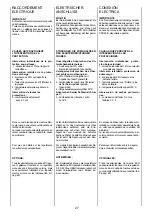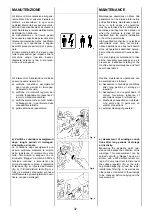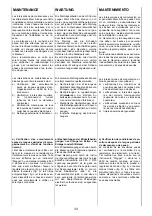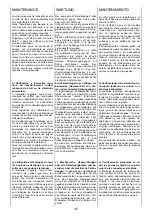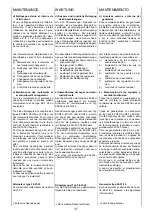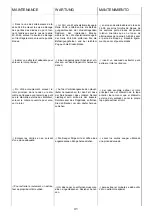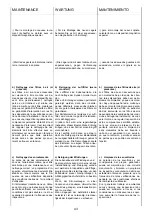
FUNZIONAMENTO IN PARALLELO
Nel caso si voglia far funzionare dei gene-
ratori in parallelo e’ necessario montare un
dispositivo che assicura un identico stati-
smo sulla caretteristica esterna.
Questo significa che se le macchine lavo-
rassero separatamente si avrebbe una
uguale caduta di tensione (circa 4%) pas-
sando da vuoto a pieno carico.
Questo dispositivo e’ montato di serie sulle
grandezze 40 - 43 - 46, per cui, quando due
o piu’ di queste macchine devono lavorare
in parallelo e’ sufficiente togliere il ponticello
che cortocircuita il secondario del dispo-
sitivo di parallelo (tav. 16-17 pag. 66).
Per le grandezze inferiori il dispositivo viene
montato a richiesta o puo’ essere montato
dal cliente stesso secondo le tav.11-13-15-
17. Dopo aver montato il dispositivo e’ ne-
cessario verificare l’esatto collegamento; si
dovra’ controllare cioe’ che le macchine la-
vorando singolarmente presentino una ca-
duta di tensione di circa il 4% passando, a
velocita’ nominale e cos
ϕ
0.8, da vuoto a
pieno carico.
MONTAGGIO DI UN DISPOSITIVO
DI PARALLELO
Riferendosi alle tavole 11-13-15-17 montare
il trasformatore di parallelo come illustrato.
Attraverso il morsetto isolatore, consegnato
con il dispositivo di parallelo, collegare le
spire di potenza in serie alla fase.
Il numero delle spire da eseguire sul trasfor-
matore saranno indicate sulle istru-zioni al-
legate al trasformatore stesso.
Il secondario del trasformatore di parallelo
va connesso in serie al riferimento del rego-
latore elettronico come mostrato nelle ta-
vole 4 e 5 pag. 59.
Per abilitare il dispositivo di parallelo rimuo-
vere il ponticello che cortocircuita il secon-
dario del dispositivo stesso come mostrano
gli schemi sopra indicati.
NOTA
Alla richiesta del dispositivo di parallelo e’
indispensabile conoscere i dati nominali del-
l’alternatore su cui andra’ applicato.
Dopo aver eseguito tutti i collegamenti elet-
trici e
solo dopo aver chiuso tutte le pro-
tezioni
e’
possibile effettuare la prova di
primo avviamento del sistema.
ACCOPPIAMENTO
ELETTRICO
28
ELECTRICAL
CONNECTIONS
PARALLEL OPERATION
Should the alternators be required to ope-
rate in parallel, it is necessary to add a
paralleling device to ensure equal droop of
generator output voltages.
This ensures that if the machines are opera-
ted separately, the voltage droop (4% ap-
prox.) is equal when switching from no-load
to full load.
The parallel device is fitted as standard on
40-43-46 models, therefore when two or
more of these units must function in parallel,
it is sufficient to remove the bridge which
shortcircuits the secondary winding of the
parallel device (tables 16-17 pag. 66).
On smaller models this device is mounted
on request or it can be added by the client
himself following the instructions of tables
11-13-15-17.
After the device has been mounted, check
whether the connection has been properly
made; make sure that there is a voltage
drop of approximately 4% in the machines
when they function individually switching at
rated speed and cos
ϕ
0.8 from no-load to
full load operation.
HOW TO MOUNT THE PARALLEL
DEVICE
Referring to tables 11-13-15-17 mount pa-
rallel device as indicated.
Through the insulating terminal, which is
delivered together with the parallel device,
connect the power turns in series with
phase. The numbers of turns to be wound
on the transformer will be indicated in the
instruction accompanying the transformer
itself. The secondary winding of the parallel
transformer must be connected in series to
the sensing of the electronic regulator as
shown on tables 4 - 5 page 59.
In order to activate the parallel device re-
move the bridge which shortcircuits the se-
condary winding of the device itself as
shown in the above mentioned tables.
NOTE
When requesting a parallel device, it is ne-
cessary to indicate the nominal data of the
alternator on which the device will be ap-
plied.
After all the electric connections have been
made and
only after all the protections
have been put in place,
can the system be
started.














